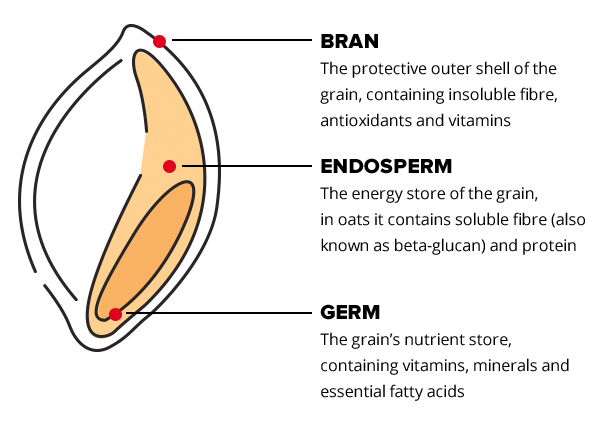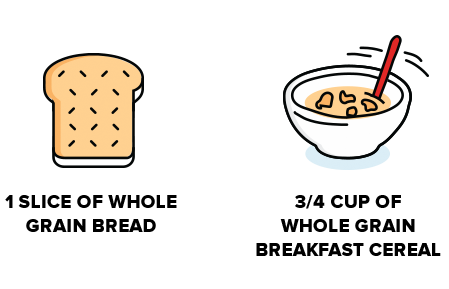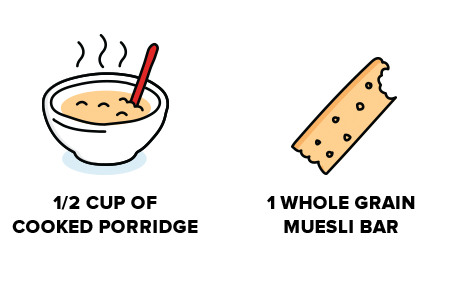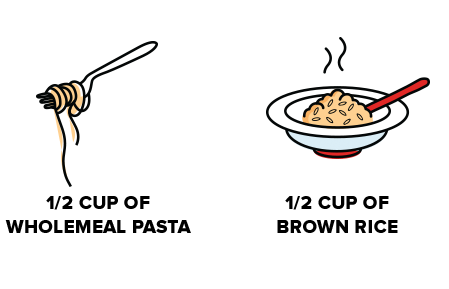What does ‘whole grain’ mean, exactly?
The term ‘whole grain’ doesn’t refer to one particular type of grain. Rather, it means an entire grain, with all three of its parts intact. Oats, rye, barley, wheat, brown rice, quinoa, millet and many other grains can be whole grains, as long as their parts are all present.
The three parts of a whole grain

Why whole grains do you good
Compared to refined grains, whole grains have more nutrients like minerals, vitamins, dietary fibre and antioxidants. So by including more whole grains in your diet, you’ll be getting more of these vital nutrients and making sure you’ve got the wholesome energy you need.
Why choose whole grain cereals and snacks?
Nutritionists recommend eating whole grains as part of a nutritious diet. Whole grains provide many nutrients including dietary fibre, antioxidants, minerals, vitamins, lignans and phytonutrients. It's thought that the combination of these nutrients accounts for the health benefits seen in people who consume more whole grains in their daily diet.
Every Uncle Tobys cereal and all Uncle Tobys Muesli Bars are guaranteed to be made with whole grain, with at least 8g of whole grain per serve or bar. Many Uncle Tobys products provide much more than this.
How much whole grain is enough?
Go Grains Health & Nutrition Ltd, the leading independent nutrition advisor in Australia for grain foods in human health, advises that we should aim to eat 48g of whole grains every day. And with some simple changes, such as switching to whole grain breakfast cereals or snacks, it’s easy to get your daily dose of whole grain.
How can I tell if a food contains whole grain?
With Uncle Tobys cereals and Uncle Tobys Muesli Bars, it's easy – they all contain whole grain, guaranteed.
For other foods, ask yourself:
- Does it say 'whole'? Look at the ingredients list. Any grain described as 'whole', like wholemeal, whole grain wheat, whole grain rice etc, will contain all parts of the grain kernel. The exception to this is ‘whole rice’, which is sometimes used to describe white rice. White rice and products made from the endosperm like puffed white rice aren't whole grain because they're refined to remove the outer bran layer. However, brown rice and wild rice are whole grains.
- Is it a major ingredient? If the grain is a main ingredient within the product, it'll be listed near the start of the ingredient list and so it'll make a bigger contribution to your whole grain intake.
Some common whole grains:
- Wholewheat
- Bulgur (cracked wheat)
- Sorghum
- Whole oats / oatmeal
- Popcorn
- Triticale
- Whole rye
- Wild rice
- Brown rice
- Whole grain barley
- Amaranth
- Buckwheat
Tips for getting more whole grains in your diet
- Swap refined white breads, pastas and rices for whole grain(brown) varieties
- Start your day with a breakfast cereal that's made with whole grains. All Uncle Tobys cereals are guaranteed to contain whole grain
- Switch to wild or brown rice, or mix them with white rice
- Use wholemeal breadcrumbs for topping savoury dishes.
- Choose whole grain rice cakes, rye crispbread, Uncle Tobys Cheerios, Uncle Tobys Muesli Bars or plain popcorn as a snack
Getting all the whole grains you need in a day
As a general rule, most people should try to eat 3-6 serves of wholegrains every day (that's about 48g of wholegrains).
1 SERVE =




References
- Slavin et al (2001) Grain processing and nutrition. Critical Revies in Biotechnology 21:49-66.
- Murtaugh MA et al (2003) Epidemiological support for the protection of whole grains against diabetes. Proceedings of the Nutrition society 62:143-9
- Johnston et al (1998) Cholesterol lowering benefits of a whole grain oat ready-to-eat cereal. Nutrition in clinical Care, 1:6-12
- Karmally et al (2005) Cholesterol-Lowering Benefits of Oat-Containing Cereal in Hispanic Americans. Journal of American Dietetic Association, 105:967-970
- Andon and Anderson (2008) The Oatmeal-Cholesterol Connection: 10 Years Later. American Journal of Lifestyle Medicine; 2:51-57
- Kelly SAM, Summerbell CD, Brynes A. (2007) Whole grain cereals for coronary heart disease. Cochrane Database Syst Rev
- Liu S et al. (2003) Relation between changes in intakes of dietary fibre and grain products and changes in weight and development of obesity among middle-aged women. American Journal of Clinical Nutrition 78, 920-927.
- Harland JI and Garton LE (2008) Whole-grain intake as a marker of healthy body weight and adiposity. Public Health Nutrition 11(6):554-63.
- Williams P et al (2008) Cereal grains, legumes, and weight management: a comprehensive review of the scientific evidence. Nutrition Reviews 66(4):171-182
What type of tasty goodness are you looking for?
Search our range